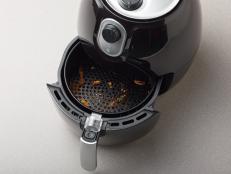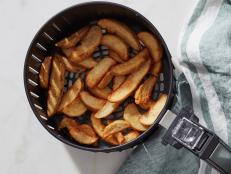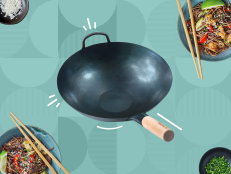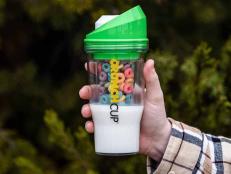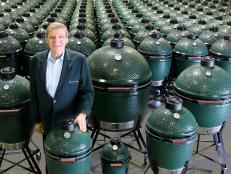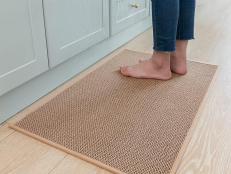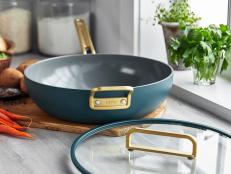I Tried 3 Popular Methods for Cleaning My Silicone Baking Mats and This Is the One I Swear By
That slippery residue that won’t budge no matter how much you scrub? Yeah, it’s gotta go.
Roman Chekhovskoy
I’m ashamed to say that, until recently, I had 4 silicone baking mats sitting in my kitchen cabinet, untouched. Brand new. Just like the day I got 'em. As much as I wanted to put them to use (and make my kitchen just a little bit greener), I couldn’t resist saving time on cleanup — so I used parchment paper for everything.
Long story short, when parchment paper became more difficult to find I had no choice but to break out my silicone mats for certain jobs. (I still use parchment for cookies — they bake up way better on paper than they do silicone). And do you know what? The dreaded cleanup process wasn’t all that bad. Sure, I now had one or two more things to scrub but with a little bit of soap and warm water they were surprisingly like new again.
Until they weren’t.
I picked one up from the dish drying rack one day and it was coated in a slick, oily residue. Back into the sink it went for another scrub — but, no matter how much soap I used, or how many times I sudsed and rinsed the mat, it just didn’t feel clean.
It turns out that this is a pretty common situation with these types of mats. When they heat up in the oven the silicone molecules expand allowing the mats to absorb oil. Over time, you end up with buildup that can’t be washed away with dish soap alone.
Thankfully, the mats can still be cleaned; they just need special attention.
If you poke around the internet you’ll see a few different suggestions for how to clean your mats. Some of them tackle residue, others promise to lift stains and eliminate odors too. With so many different methods out there (and with no dishwasher to help me out!), I wasn’t sure which one would be best — so I decided to put the 3 most commonly cited methods to the test. Here’s what happened.
Baking Soda
I was most excited about this method (it’s quick, easy and makes sense!) so I tried it first. I grabbed a small bowl and made a thick paste out of baking soda and water. The paste was about the consistency of wet sand. Then, I put the mat in my kitchen sink and scrubbed it gently with the paste. I used a circular motion and scrubbed for about 30 seconds. After that, I grabbed another handful of the paste, spread it in a thick layer all over the mat and let it sit for 10 minutes. When I came back I rinsed the baking soda off the mat, washed it with warm water and dish soap as usual and dried it with a towel. And, just like I had hoped, the residue was completely gone — the mat felt just like new.
Hot Lemon Water
The more I read up on this method the more it seemed like really hot water was key (because the hot water would expand the silicone molecules and let the lemon juice in/oil out) so I started by boiling a kettle of water on the stove. Once my hot water was ready I put the dirty mat in the sink, squeezed the juice of two small lemons over it and scrubbed the mat a little with the cut side of the lemon for good measure. Then, I poured hot water from the tea kettle over the mat and left it to soak for 10 minutes. Just like with the baking soda method, I rinsed the mat before washing and drying as usual. The lemon water was just as effective at removing the oily residue as the baking soda method was but the lemon water also lightened up the stains near the corners of my mat. I’m willing to bet that with a longer soak time, the discoloration would lighten even more.
The Oven
I’ll be honest with you, I was not excited about this method. First, it’s been a really hot summer, so the thought of cranking up the oven and leaving it on for an hour didn’t exactly appeal to me. Second, I was worried that the oil from the mat might start smoking and set off the smoke detectors — and nobody likes getting the ladder out and dealing with that. But I knew I needed to give this one a fair shot so I put the oily mat on a baking sheet, put it into the cold oven and turned the dial to 450 degrees Fahrenheit. I left the mat in the oven for one hour before moving it (with tongs!) to the sink and washing it with soap and water, just as I had done with the other two mats. It was mostly residue-free on both sides (the corners still felt a little slippery) and surprisingly free of stains and discoloration. I mean, like really sparkly and stain-free. I did notice, however, that the mat now feels stiffer than the others.
The verdict? The best method for cleaning your silicone baking mats depends on what you’re trying to achieve but, in most cases, the hot lemon water makes the most sense. I love the simplicity of the baking soda paste but am impressed at how, for just a tiny bit more effort, the lemon water tackled both residue and stains simultaneously. And, while it’s true that the oven does a better job of lifting stains, it wasn’t quite as effective at removing oily residue, which was my primary concern. Plus, the oven method takes a long time and heats up your entire house.
You can’t go wrong with any of these methods but for a quick-and-easy, double-duty fix, break out the lemons!
Related Content






















